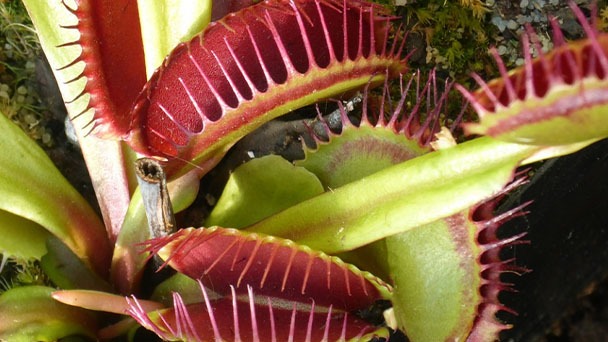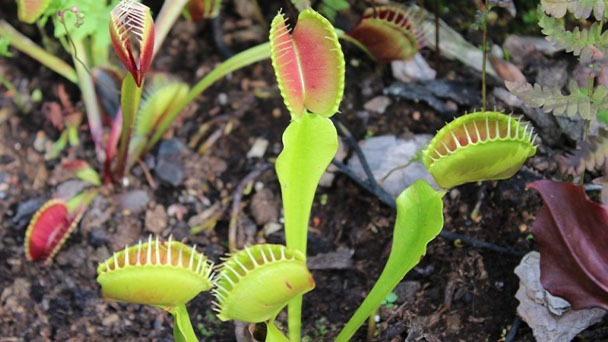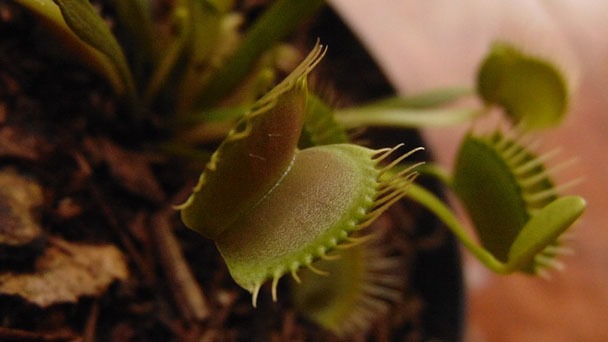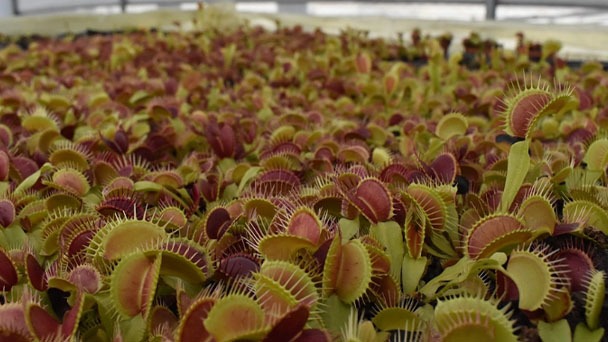How Big Do Venus Flytrap Get - Growth Rate & Speed
Written by Ivy
Jan 03 2023

A mature Venus flytrap has a diameter of 4 to 5 inches when it is fully grown. The length of each leaf will range from one to three inches.
The biggest traps will be no bigger than 2 inches. So, even when your Venus flytrap is fully grown, you will regrettably not be able to feed it your little brother.
We'll look at the largest Venus flytrap ever seen today and demonstrate why this plant is deserving of our attention in every way.
What is a Venus Fly Trap?
A carnivorous plant called a Venus flytrap, which is in danger of extinction, catches its prey in a specific area of its leaves. The four to seven-leaved plants frequently form small clusters. Each one of them leads to a trap, an opening and closing structure. Usually measuring between 0.5 and 1 inches wide, these traps have extensions along the closing edges that resemble teeth.
There are tiny trigger hairs all over the interior of the trap. The trap closes when the structures detect an insect touching it. This is a complex process that we will detail in the next section.
There's a good reason why some individuals may not have heard of this plant. After all, it is only native to a small portion of South and North Carolina in the United States. They typically thrive in bogs because there is less competition for resources and less grass and groundcover there.
Let's look at how plants eat now that we have a basic understanding of them.

Do Venus Flytraps Get Big?
No, a venus flytrap won't grow to be a huge plant either inside or outside. Your plant will typically mature to a diameter of 5 to 6 inches.
Venus flytraps don't grow particularly big at any point during their lifetime, unlike in a science fiction film. Each trap on your plant has the potential to grow to a height of 1.5 inches, as we already mentioned, but that is not always the case.
A venus flytrap may live a relatively short life, depending on its surroundings. So if you want a plant for the window sill, a venus flytrap is the ideal choice.
Venus flytraps don't grow very tall, so many people grow them in terrariums with heat lamps.
This can be a fantastic way to observe your plant at work, but you'll need to give it flies so it can eat.
Do Venus Flytraps Grow Quickly?
No, a venus flytrap isn't going to grow very fast. This plant species is regarded as slow-growing because it frequently takes years for it to flower and develop fully.
As an illustration, venus flytraps frequently start displaying their carnivorous traps soon after germination. However, it will take your plant 3–4 years to flower, so this is a waiting game.
Don't get discouraged if your plant isn't growing much; venus flytraps can live for more than two decades, giving it plenty of time to mature (slowly).
The germination times for venus flytraps, on the other hand, are usually quite quick. You can usually see sprouts within 10-14 days post-planting, so there's good news for you.
It's also important to note that venus flytraps thrive in outdoor environments, though it can be challenging to replicate their ideal environments.
How Does the Venus Flytrap Find Its Food?
The Venus flytrap's trigger hairs are found on the interior of the trap, as we've already mentioned. To cause the Venus flytrap to close, a very particular type of stimulation is needed. The trap won't necessarily close after just one instance of contact.
If not, there would be too many false positives and the trap would close. The plant would lose out on important nutrition. As a result, for the trap to be set off, two contacts must happen in a span of 30 seconds or less.
Once the right stimulation occurs, the trap will close. The initial springing of the plant may occur in less than a second, but it takes minutes for the entire leaf to close up. The plant then seals off, releases a flood of digestive enzymes, and consumes the bug once the food has been trapped. Over the course of about a week, the plant gains beneficial nutrients; following which, the trap opens again in anticipation of a new meal.
Of course, other stimuli could also cause these plants to shut down. The trap portion can be filled with objects that humans can then push shut. The plant will wither if you do this too frequently.
What Do Venus Flytraps Eat?
The majority of the food that Venus flytraps consume are insects and arachnids. But the size of the plant is one of the most important factors in determining what a flytrap eats.
Some of the most common foods eaten by this plant include:
- Grasshoppers
- Flies
- Spiders
- Ants
- Beetles
These insects are the proper weight and size to fit in the traps. They are also most likely to enter the trap and set it off, making it close.
Measuring the Largest Venus Flytrap
Measuring the width of the plant's trap is the simplest way to determine which Venus flytrap is the biggest. Measuring the entire plant's size doesn't really tell us which branch is the largest on these plants because they develop multiple offshoots on them.
Also possible are larger, tangled clusters of these plants. Below the soil, they occasionally split into colonies. Therefore, attempting to gauge these plants by their general size is somewhat pointless. In order to determine the record-holding size, it is best and most accurate to concentrate only on the trap mechanism.
How Big Was the Largest Venus Flytrap?
The largest Venus flytrap was 2.4 inches across in the middle. The plant is the property of Jeremiah Harris, a citizen of the United States. The plant was grown from a cultivar that is nicknamed "Alien." Like many other plants, the Venus flytrap has a variety of cultivars that have been selected for particular characteristics.
The Alien cultivar in this instance is renowned for producing rather large traps on the ends of the plant. Due to their width and length, the 2.4-inch traps almost resemble pea pods. It is currently unknown what diet Harris feeds them to help them achieve this large size.
Another interesting thing about this record-holding Venus flytrap is that the previous entry was another Alien specimen. Jeremiah Harris also grew this one, which was 1.96 inches long. This record was issued in 2020. We don't know if there is fierce competition to grow the biggest one of these plants or if Harris is just very good at it.
Regardless, it appears that this new record marks the first time a flytrap larger than 2 inches has been grown and noted. The Colorado Carnivorous Plant Society was founded by Harris, who also maintains a sizable collection of these plants, according to a website he created.
Harris might soon try to break another record given the recent increase in carnivorous plant growth and records that have already been broken. Currently, we don't know what the upper limits of the trap sizes are or how they can be reached.

How Often Should You Feed a Venus Flytrap?
Your venus flytrap needs to be fed now that you are familiar with the fundamentals. Typically, you want to release a fly or two near your plant every two weeks.
This will vary depending on the individual as some experts advise weekly feedings for plants that grow more quickly. Keep in mind that venus flytraps grow better and more quickly the more nutrients they have.
Although a venus flytrap can survive without food for extended periods, starving one isn't beneficial. It's not a good idea to skip a feeding if you want to see yours bloom and get bigger.
On the other hand, if your Venus flytrap is outside on the porch or even buried, you shouldn't need to feed it at all. Since this species of carnivore can survive quite well outside, many people prefer to keep theirs outside.
If your winters are colder, you can move a venus flytrap outside in the summer so you won't have to feed it then.
So we advise keeping your venus flytrap outside because it requires less maintenance.
How Long Can a Venus Flytrap Live Without Food?
For a month or two at a time, you can usually stop feeding venus flytraps. Considering that even indoors, your plant will likely find a fly, this isn't likely to happen.
Let's assume, though, that you do not feed your plant and that it is unable to capture any prey. Although it might seem as though your venus flytrap is doomed, it can survive for extended periods of time without eating.
As we mentioned above, this species relies heavily on photosynthesis. A venus flytrap can thus go for extended periods without insects as long as it receives enough sunlight.
However, because this is a critical period for your plant's growth and development, we do not advise starving it when it is young.
Your venus flytrap won't grow or bloom if you don't give it enough food.
What Happens If a Venus Flytrap Bites You?
What if you accidentally stick your finger in one of your plant's traps? Generally, you will see the trap close quickly on your finger, although this won't harm you.
Touching one of your houseplant's carnivorous traps may result in a bite, especially if it is hungry. A venus flytrap, despite its frightening name, has teeth that feel more like eyelashes than spikes or prickles.
It's a common misconception that venus flytraps have cactus-like teeth that clamp down on their prey. This is untrue.
Therefore, if your plant bites you, it will probably feel more like a tickle than anything painful or serious.

Venus Flytrap Care Tips
Light
Bright, filtered light is ideal for Venus flytrap growth. In the summer, it's especially important to keep them out of direct sunlight because it can become too hot and turn the leaves crispy. Flytraps need 4 to 7 inches of space between them and fluorescent lights when grown indoors under artificial lighting. Give your plant more light if the traps don't have a pink interior or the leaves appear long and spindly. (Read More: Venus Fly Trap Light Requirements - Does It Need Direct Sunlight?)
Soil and Water
Venus flytrap thrives in poor, acidic soil that retains moisture but still has good drainage. A mixture of one-third sand and two-thirds sphagnum peat moss offers the best drainage and moisture retention, so avoid planting it in regular potting soil.
Keep the soil moist, but avoid submerging the plants in water all the time. Never give your plants tap water; it's typically too alkaline and may contain too many minerals. Instead, rely on rain or use distilled water.
Temperature and Humidity
The Venus flytrap can tolerate temperatures as low as 40°F in the winter with protection, but it prefers temperatures between 70°F and 95°F. Maintain a humid environment for the best Venus flytrap propagation. Turn on a fan in the room where you keep your Venus flytrap plants because proper air circulation is essential for their growth.
Fertilizer
Venus flytrap plants shouldn't have lime or fertilizer added to their soil. These plants obtain the nutrients they require from their prey.
Do Venus Flytraps Live a Long Time?
Yes, the venus flytrap's long lifespan is one of the many advantages it has. A typical flytrap will live between ten and twenty years, and under ideal circumstances they can even live longer.
Additionally, the slow rate of maturation of these carnivorous plants makes the long lifespan useful.
One thing to keep in mind is that a venus flytrap depends heavily on photosynthesis to grow, so if yours doesn't get enough sunlight, it might not live as long.
Additionally, venus flytraps require the energy of flies and other small insects to develop, so make sure your plant is well-fed and situated.
These plants must obtain the nitrogen they need from the insects they consume because they thrive in soils that are low in nitrogen.
How Do You Keep a Venus Flytrap Alive Indoors?
For anyone wanting to grow their flytrap inside, this is pretty easy. Find a venus flytrap first in an area with lots of light.
However, since direct sunlight can cause burning, your plant doesn't necessarily need to be in it. Instead, a window sill with the indirect sun is fine if you're somewhere in the southern hemisphere, while six hours of sun is needed for anyone in the north.
It should be sufficient to place your venus flytrap under a grow light for 10–12 hours each day if you are unable to duplicate these conditions.
Again, you probably won't need a grow light unless you don't have any windows that face the sun, so consider that more of a last resort.
It's typically best to let the sun's actual rays shine down on your venus flytrap so that it can properly photosynthesize.
Final Thoughts on the Biggest Flytraps
The Venus flytrap is a rather unique and somewhat beautiful plant in its own way. It does indeed eat insects. It is a complex creature, though, and it appears to straddle the animal and plant worlds. It's a plant, after all.
It's alarming how scarcely this carnivorous plant is found in its natural habitat. Despite being widely spread throughout the world today, the plant is dwindling in the Carolinas. Unfortunately, many of the conditions that help it grow, flooded savannahs, bogs, and fire-prone areas, are disappearing. In its original location, this plant might get much more difficult to locate.
Frequently Asked Questions
Can a Venus Flytrap Hurt Me?
A Venus flytrap isn't strong enough to "bite" you with any power. The plant is more likely to suffer damage than you are if you stick your finger inside of it.
How Big Do Venus Flytraps Get?
When fully grown, the majority of Venus flytraps are no bigger than 5 inches tall or wide.
Does Venus Flytrap Have Any Predators?
The plant is prone to aphids and spider mites indoors. They have been known to be nibbled on by raccoons, birds, and squirrels outside.
Read More About Venus Flytraps
- Will Venus Fly Trap Bloom Flowers - Is It a Perennial Plant
- Are Venus Fly Traps Animals or Plants - Are They Illegal?
- How Long Can Venus Flytraps Live - Venus Flytrap Life Cycle
- How Does the Venus Flytrap Work?
- How to Repot a Venus Flytrap
- How Much Does Venus Flytrap Cost
- How Does A Venus Flytrap Kills & Eat Insect - RayaGarden
Latest Updated
- Benefits of Bugleweed - 7 Science-backed Health Benefits
- Bugleweed Dangers & Side Effects - Is It Poisonous?
- How to Plant Evergreen Trees - What You Should Know
- When to Plant Evergreens - Grow Guide for Evergreen Trees
- 12 Wonderful Evergreen Shrubs for Your Garden
- 12 Popular Evergreen Plants with Pictures for Beginners
- When And How To Prune A Lilac Bush Like a Pro
- How to Grow & Care for Lilac Vine (Hardenbergia Violacea)
- Japanese Lilac Tree (Syringa Reticulata) Care & Propagation Guide
- Shumard Oak Pros and Cons - What to Know
Popular Articles
- Winter maintenance of Antirrhinum Majus
- How to Grow Terminalia Mantaly Tree
- How to Grow and Care for Crossostephium Chinense
- How to grow Antirrhinum Majus in spring
- Peristeria Elata (Dove Orchid) Profile: Info & Care Guide
- Underwatered Snake Plant (Sansevieria Trifasciata) - Signs And How To Fix
- How to Care for Brazilian Jasmine Plant (Mandevilla Sanderi)
- How to Grow & Care for Graptopetalum Purple Delight in Summer
- Rosa Chinensis (China Rose): Plant Growing & Care Tips
- How to Care for Baby Sun Rose (Aptenia Cordifolia)